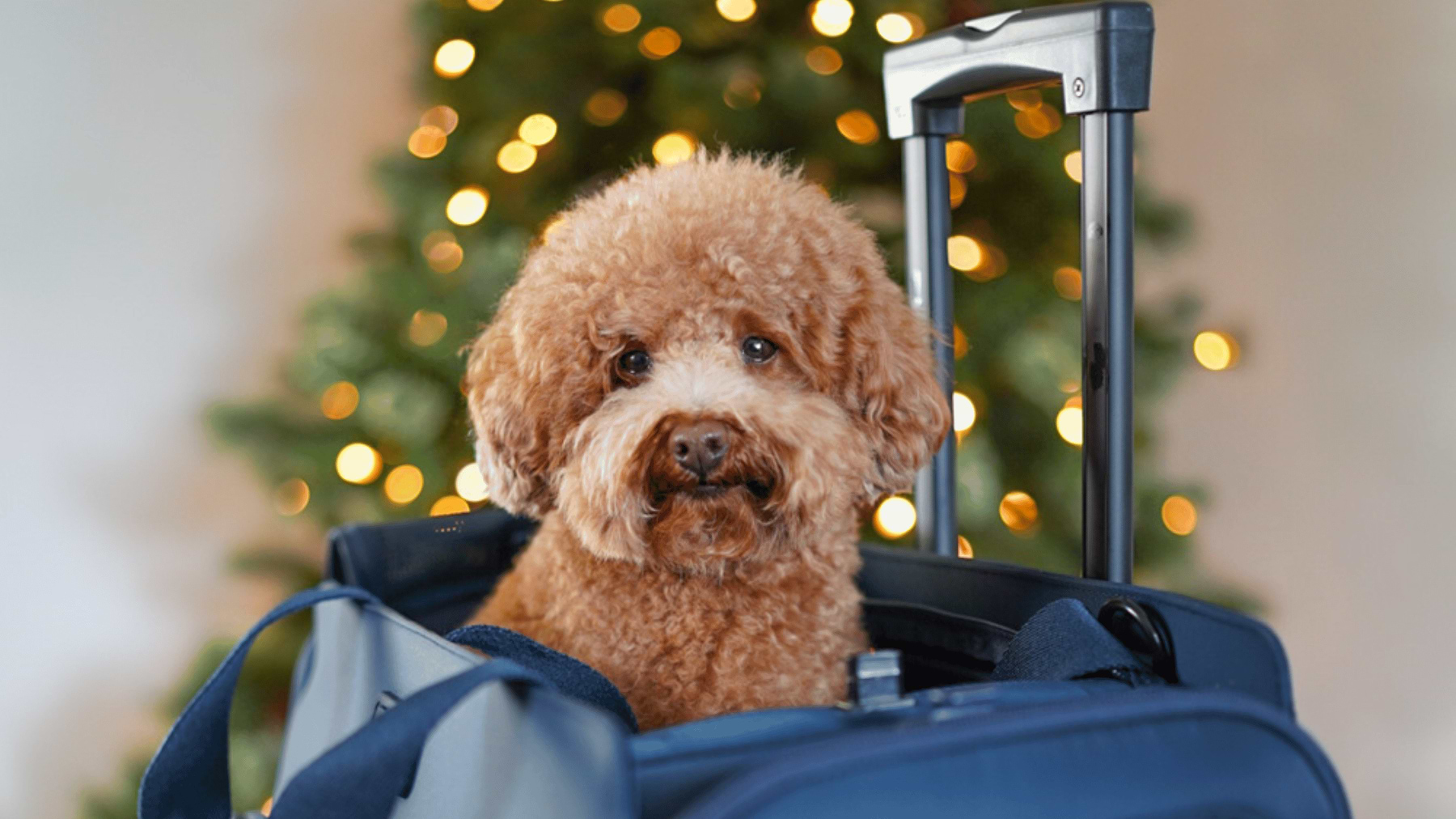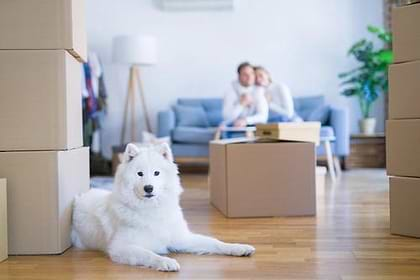Ready for the holidays? Excitement is commonly expressed amongst people, but pets might feel differently. Just a simple change of routine can have an impact on the stress level of your pet.
Don’t worry; there are tips you can follow to help prevent your furry friend from feeling overwhelmed, allowing you both to share the festivities of the holiday season.
A Pets’ Reaction to Visitors
Holidays bring friends and families together. Are you expecting to have a revolving front door, or are you hosting parties? You may be ready to welcome visitors into your home, but is your pet? A familiar face to you may be unfamiliar to your pet.
Pets handle situations of stress and anxiety in different ways. Some may be shy, others aggressive. To help alleviate the tension, you have options.
A Comfortable, Quiet Space
Try and set up a place where your furry friend can escape. The area should not have guest traffic. Instead, it should be a quiet space with items of comfort. Include your pet’s food dish, water bowl, favorite toys, and most importantly, a comfortable place to relax and snooze.
Puzzle toys and toys that you can stuff with treats, or calming training aids like our Groov Crate Training Aid with Treat Spreads are a fantastic option and can keep your furry friend busy within their quiet space.
Socialization Training
A second option involves socializing your pet. You can teach them that new people invading their territory can be okay, especially if visitors are common in your home.
You can practice socialization training from home. Identify a treat that your pet finds rewarding. This is the motivation behind the training.
Start off small, with one unfamiliar face to your pet. Have that person greet your pet and offer the treat. The pet associates the treat with positive reinforcement and will be encouraged to exhibit acceptable behavior when asked. Continue to repeat the process, slowly introducing more people to your home that your pet doesn’t know.
What’s for Dinner?
There is something about the holidays that encourages baking (Christmas cookies, anyone?), and lots of different dishes to share. But sharing should not necessarily be with your pet unless it is prepared specifically for them.
Food safety is important, regardless of the season! In fact, some foods are hazardous to your pet.
Here are a few foods you will want to avoid coming into contact with them:
- Chocolate is a delicacy, but it is toxic to dogs and cats. The level of toxicity depends on the type of chocolate and the amount consumed.
- Baked goods and sweets containing xylitol are dangerous and should be avoided at all costs. Other artificial sweeteners, such as stevia, erythritol, etc., may not cause serious side effects, but should still be kept away from your pet.
- Turkey and turkey skin are on the list. If prepared plain, there is no concern; however, have you ever cooked a holiday turkey without adding seasonings or stuffing? The turkey skin is full of fat and creates the risk of pancreatitis. Seasonings to avoid include onions and garlic as both are considered toxic to dogs.
If you’ve set up a chair for your pet to join you for dinner, make sure the recipe you use includes ingredients that are safe for your pet or are properly formulated for them. Also, if you are serving alcoholic drinks, place them where your pet is unable to reach them.
Holiday Decorations Can Be Dangerous
Ready to unbox those decorations and get the holidays started? Of course you are, and your pet may have a steady eye on a few flashy items too. Decorations are temptations to pets, so be mindful as you are setting up.
Let’s take a look through different types of decorations that could pose a risk to your pet over the holidays.
Christmas Trees
It is common for a home to welcome a real or artificial tree. But what is your pet thinking? Maybe for a cat, it’s a great scratching post, or a dog may see the ornaments as play toys. What should you do?
- Check for ways to anchor or secure the tree to remove the risk of it falling over. Think about tying it to a doorframe or ceiling, or placing a gate around it.
- If it is a real tree requiring water, only add water. Do not include additives such as aspirin or sugar.
Now for the tree decorations. Adding ornaments to a tree adds character and beauty, but not all ornaments are safe for pets. There are options for glass ornaments and plastic. There are also homemade ornaments that contain toxic ingredients. For example, salt-dough is used to create hand-print type ornaments.
Tinsel is another common decoration that pets try to play with and consume. Regardless of the type of ornament or decoration used on the tree, there is a chance your pet could ingest them, leading to severe medical issues. Place your ornaments where your pet can not reach them, or be enticed to interact with them.
Lights, Sounds, and Smells
What better way to provide the ambiance of the holidays in your home than by adding garland to your stairway, lights to your windows or tree, and burning candles to fill the air with cinnamon or balsam? We don’t always associate these as dangers to our pets, but they can be.
Lights
Lights are fun and frustrating at the same time, especially when they get twisted and tangled. Pets are attracted to them too. They are quick to gnaw on the wire, creating short-circuits.
Since this is an electrical cord, the wire can shock your pet or lead to death. On a positive note, you can easily purchase PVC piping or cord protectors. These keep your pet safe and reduce the frustration you may have of lights not working.
Candles
Keep candles out of your pet’s reach. Or, as an alternative, use battery-operated candles. Candles have an open flame that not only is dangerous to your pet but to your home if not properly monitored.
Like candles, avoid using potpourris too. Pets may try to consume these if in solid form. Liquid potpourris contain essential oils and detergents. These can cause a reaction to your pet’s mouth, eyes, and skin.
Flowers and Plants
Did you know that there are certain flowers and plants your pet should not be around? Some are poisonous to pets if they are consumed. A few of the most common that you should avoid include amaryllis, poinsettias, mistletoe, balsam, pine, cedar, and holly.
The alternative? Use artificial flowers and plants.
Fireworks
Celebrations are overwhelming for us all. As guests begin to leave or head outside, your pet may think the night is over. Then, they hear loud noises echoing and repeating. What is it? Fireworks.
Loud noises, or sudden noises, in general, are frightening to some pets. If your pet startles or stresses easily, find ways to comfort their ears and help them to feel safe. You can:
- Chart a course before dark and take your pup out for a long walk on a leash. Depending on where the noises are located, you may be able to avoid the startling sounds and keep them focused on exercise.
- Desensitize your pup to the sound of fireworks and loud noises. This one is more of a training process, but play the sounds softly and teach them that it is okay; they are safe.
- Provide a go-to place for your pet to retreat to and relax, like a safe and sturdy crate. Dogs are den animals and prefer to find a “cave” to withdraw to. Locate a space that is away from windows, if possible.
- Find another source of noise to drown out the loud sounds. Use white noise from a fan, air conditioner, or a white noise machine. Play calming music, or broadcast a show on the television.
- Depending on the severity of the stress, you may want to consider talking to your veterinarian. There are calming oils that are safe for your pup. Your vet may also recommend medications to soothe them.
If you have the ability, be with your pet and sympathize with them. Sometimes you are their strongest source of comfort, you are their best friend after all.
Safe Traveling
Are you planning to travel over the holidays? Regardless of the form of travel, it is not the normal routine for your pet and can cause added stress.
If you are traveling with your pet, do your research beforehand. Choose a method of travel to use and make preparations ahead of time. Bring the essentials your pet will need such as food, water, and toys. Bathroom breaks are also important to map out, especially if you are traveling by car.
Keep your pet safe when traveling by knowing where they are at all times. That may mean they are on a leash or laying comfortably within a travel carrier. You should also verify that their collar and tags are intact, just in case you are separated from each other.
The Bottom Line
You may be excited to kick off the holidays, but your pet may think differently. Keep your home safe, comfortable, and stress-free for your pet by taking precautions. Stick to the normal routine as much as possible to prevent your pet from becoming stressed.
If you are considering adding a new furry friend to your home, during the holidays is not the best time. Prepare and plan ahead whether you are traveling with your pet or expecting visitors at your home. Unplug decorations and blow out candles. Only then can you keep your pet calm and enjoy the magic of the holidays.
Diggs provides portable, ergonomic options for your pet to retreat to during the holiday season. Click here to see our full catalog of stylish, functional pet products to help you introduce luxury and comfort to your home for both you and your pets.
Sources:
6 Ways to Make the Holidays Less Stressful for Dogs | AKC
Tips for reducing your pet's stress during the holidays | UGA
Keep Your Dogs and Cats Safe From Holiday Hazards | FDA
Winter holiday pet safety | AVMA
Keep Your Pets Calm During the Holiday Season with These Tips | Corydon Animal Hospital
How to Keep Your Dog Calm During Fireworks | American Kennel Club
You might also like
Crate training tips, stories and inspiration
View all blogsIn Your Diggs
Share your photos with #DiggsPet and tag us @DiggsPet on IG and TikTok.



